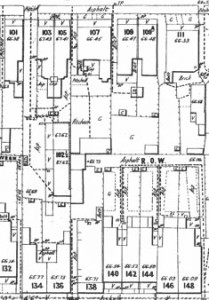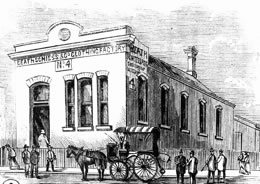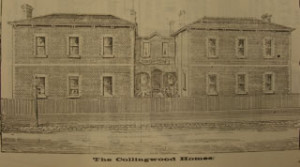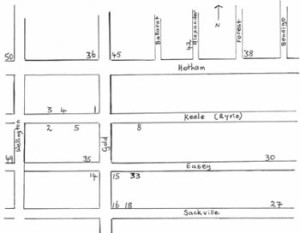Gold Street Precinct and Surrounds
This area (Yarra Heritage Overlay 321) represents the largest surviving group of early residential buildings in Collingwood. It consists mainly of modest timber and masonry workers cottages, interspersed with occasional industrial and commercial buildings. The primary development period is the late nineteenth century and early twentieth century. A secondary contribution comes from a scattering of interwar houses and factories.
This brochure describes a number of individually significant buildings, but we also want to absorb the area’s heritage as a working class industrial suburb, with its rows of housing, corner shops, dairies, local pubs, churches, and employment opportunities. While looking at buildings, we can also observe the nineteenth century infrastructure of bluestone pitched road paving, laneways, crossings, kerbs and channels and asphalt paved footpaths.
A limited number of buildings are described; if you walk around again, you will see dozens of others that will also be of interest.
Beginnings
We acknowledge the Wurundjeri people as the early inhabitants of this area.
Collingwood land was first auctioned in Sydney in 1838-1839, in large allotments. The area bounded by Hoddle, Smith, Johnston and Reilly St (Alexandra Pde) was described as Portions 80, 81, 86 and 87.
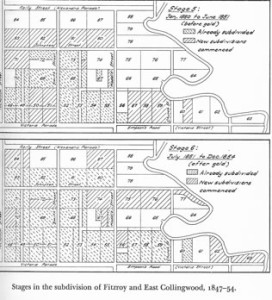
Subdivision of the southern end (Portions 80 and 81) by private developers commenced in 1850. Portion 87 was subdivided in the early to mid 1850s, after the gold rush commenced. (From Barrett, The Inner Suburbs)
Collingwood’s population increased dramatically after the gold rush, but much of this area was poorly drained and subdivision proceeded slowly.
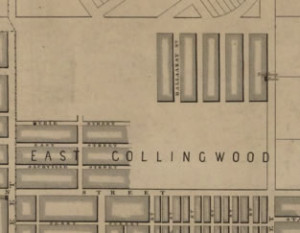
Kearney, Melbourne and its suburbs, 1855. Gold, Ballarat, Bendigo, Alexander and Forest Sts, in Portion 87, were named after the principal Victorian goldfields.
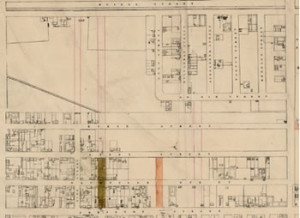
Plan shewing the streets and buildings in existence in East Collingwood on January 1st 1858, compiled from surveys executed under the direction of Clement Hodgkinson.
Drawn lines indicate suggestions for extending Budd, Wellington and Gold streets.
As far as we know none of the buildings on this map remain.
1. McNamara Reserve, a small park since the 1920s.
Keele St. a predominantly residential street of mainly single storey single fronted Victorian houses, with a greater proportion of industrial buildings at the western end around Wellington St and towards Smith St. In 1874 there were only a few houses in the section from Gold St. to Hoddle St. It was originally called Ryrie St, after an early landowner; Keele was Mayor of Collingwood in 1889-90.
2. 75-81 Keele St. Terrace of four houses in a simple early design without firewalls. The Melbourne Building Act No. XXXIX was an act for ‘regulating buildings and party walls, and for preventing mischiefs by fire in the City of Melbourne’. It took effect from 1850, and required buildings to have a permit, to be made of non-combustible material if not isolated by setbacks, and to separate different occupancies by fire walls passing through the roof. However Collingwood was outside the area covered by this Act and it would be many years before such regulations were applied, markedly altering the appearance of terraced housing and row shops.
3. 68 Keele St Shamrock Villa. A double-fronted Victorian villa with its name in glass over the door, niches, and iron lacework incorporating birds, probably Australian.
4. 74 Keele St. Double fronted bluestone residence constructed 1867. Unpainted render side walls.
5. 97 Keele St. Former Everfresh Snowball Company, a small industrial building in the Moderne style with distinctive bi-chrome brickwork. The factory was built in 1939 for Samuel Pimlott, a plumber who had previously owned a stone house and garage on the site. Features an unusual timber louvred vent at the roof apex. The company is now called Everfresh Confectionery (in Coolaroo).
6. 99 Keele St. Timber ‘miner’s cottage’ with a double-hipped roof.
7. 101 Keele St. 1930s house. Look at detail of brick fence.
8. 105 and 107 Keele St. Pair, note rear two storey sections with unusual wide chimneys.
9. 118-120 Keele St. Pair of houses with decorative bi-chrome brickwork in the facades, one over-painted.
10. 138 Keele St. Render has been removed from front, revealing the underlying structure of bluestone with brick quoining. Its twin was modernised in the post-war period.
11. 54 Gold St, south corner Keele St. This was a grocer’s shop held in the same family for at least 60 years. Retains corner splay with shop door; position of shop window is visible, now bricked up.
12. 41 Gold St, south cnr Little Abbot St. Old shop – vestiges of signs on either side of the corner doorway. In the late 19th and early 20th century it was a laundry.
13. 33 Gold St. former corner shop. Various uses over the years: fruiterer, butcher and confectioner.
14. 31 Gold St. (NE cnr Easey St). Carter’s Arms Hotel, 1872 to 1914. A confectioner’s after closure.
15. 30-32 Gold St (SE cnr Easey St). The corner building was a shop for many years, mainly a grocer’s; the splayed corner has been altered. Vestiges of advertisements can be seen on the Easey St upper wall. The neighbouring building was originally a house with a verandah at ground level.
16. 12-14 Gold St. Rev T A Eunson, who was minister of the Sackville St Baptist Tabernacle from 1908 to 1950, bought this house with his wife in 1918 and lived there for many years . It was originally two houses and has been altered at the front, incorporating unusual detailing.
17. Sackville St laneway at rear of John Wren’s Tote. John Wren lived in Collingwood from 1871-1901, though he had ongoing connections which lasted until his death in 1953. The Tote was only a very small bit of his life – the 14 years from 1893 to 1907. Wren later owned racecourses, newspapers, and theatres and had a finger in many business pies. The Tote provided an illegal gambling venue for locals and was raided many times by the police, including the infamous nine week police stake out from Cup eve in 1903. The description of the Tote in the Truth at the time provides the most detailed contemporary description of its operations.
We are at the rear of what was 134-136 Johnston Street. Shop 136, the easternmost one, was the front for gambling in the yard behind. The directories for 1893-1907 describe the shop variously as a tobacconist and a tea-merchant and give either John Wren or William Cullen as the householder. Originally the entrance was through the shop, but from 1896 punters entered from Sackville Street. There was an elaborate structure of two lots of doors across the lane, and masked staff. If you look at the MMBW map you can easily see the structure of the Tote along with dunnies for the punters. There were three escape routes: rights of way (ROW) on either side of the two shops and another ROW leading further east parallel to Johnston Street and thence into another lane which opened into Johnston Street
MMBW Detail Plan dated 1901 shows the lane leading from Sackville St to the tote (no. 102 1/2 ) and the many rights-of-way facilitating escape in the case of a raid.
18 . 96A and B Sackville St. Two modern blocks of flats are on the site of Baptist Tabernacle, built 1878, demolished sometime after 1955. Thomas Archibald Eunson was the minister from 1908-1950.
19. 98-100-102 Sackville St. Three houses built between 1912 and 1918. There used to be a timber factory on this site, originally a boot factory which was later briefly used as an orphanage in the early 1880s until a new orphanage was built in Easey St.
20. 104 Sackville St. a narrow brick factory, probably the site of Beath, Schiess and Co. Factory No 4, later Hyam’s boot factory.
21. 106 Sackville St. Site of a double fronted brick house owned by Beath, Schiess & Co and apparently built to house their factory manager. Rev Eunson lived here briefly before moving to the corner. Small brick factory now on site believed to have been built around 1919.
22. 108 Sackville St. Two storey factory built in 1881 for Beath, Schiess and Co. (Factory No 2). Later a boot heel manufactory, then Mushin Bros.
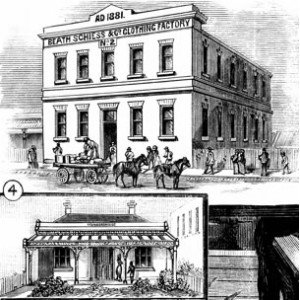
From the Illustrated Australian News 13 May 1882. Sackville St factory No. 2 and manager’s house. The house was probably the one that used to be 106 Sackville St and was later the residence of Rev T A Eunson around 1918.
23. 112 Sackville St. Former Beath, Schiess & Co. manufactory, three storeys, built 1888. Later Mushin Bros. factory/warehouse. Beath, Schiess was established in the 1860s in Flinders Lane. They profited from Protectionism (tariffs on imported goods) as they could produce clothing cheaper than English imports; one of their main products was moleskin trousers. By 1887 the two storey Sackville St factory was employing more than 400 hands, and still could not keep up with orders, hence the need for this new building; by the end of the century the company had moved out.
24. 130-132 Sackville St. Belfast Cottage, a timber pair built in 1873 without a fire wall.
25. 134 Sackville St. Block-fronted timber Victorian house.
26. 136 Sackville St. Singapore Cottage, an imported prefabricated 1850s house re-located to this site. The population explosion caused by the gold rush led to a severe housing shortage of housing and tradesmen hence the need for such cottages. On the Victorian Heritage Register. Former location of T. Cochrane’s dairy – the stables remain at the back.
27. 140 Sackville St. Edwardian. Previously a Victorian double-fronted house was on this site. A great rarity in Collingwood with its side gardens.
Easey, Keele and Hotham streets are largely intact streetscapes. The long blocks without a cross street between Hoddle and Gold streets provides long vistas of mainly single-fronted houses.
28. 155 Easey St. Bryce & Duncan Pty Ltd.
29. 139 Easey St. Early double fronted bluestone, probably 1860s and perhaps the residence of Charles Morgan, a mason. Now over-painted.
30. 160-166 Easey St. Factory late 1920s or 1930s. Overpainted. Prior to the factory construction this was a garden with timber stables at the rear. In the 1940s it was Monarch Shoes Pty Ltd.
31. 158 Easey St. Very narrow weatherboard.
32. 125 Easey St. Double fronted brick house constructed 1868. Large block, long front garden, early unpainted timber picket fence and privet hedge. Classified by National Trust.
33. 85-95 Easey St. Site of the Home of Hope orphanage, which closed in 1925. It was then bought by Mr Usher Richardson and divided into three blocks, with the orphanage building used as two factories. By 1935 these were described in the Council ratebook as ruins.
33A. 91-91A, 93-93A, 95-95A Easey St. Notable Interwar group of well-preserved bungalow style duplexes with distinctive brick detailing, original fences, well-detailed brick dressings around window openings and in gable ends. Constructed 1936. Unfortunately some brickwork has been painted.
33B. 85-87-89 Easey St. Group of three houses built mid to late 1920s on the playground area of the orphanage.
34. 98 Easey St. Look down the side to see the unusual design of the double hipped roof.
35. 92-94 Easey St. Well-preserved brick and render factory in Moderne style, with distinctive details such as the sunburst keystone, doorway, stepped parapet and string mould.
Built 1933 for Norman Trescowthick, a well-known name in Collingwood boot industry. He let it to Aristocrat Shoes Pty Ltd; it later housed C J Braun and Co shoe manufacturers.
36. 63 Gold St, cnr Hotham St. Corner grocer’s shop, one of the few still operating, although with the ground level modernised and verandah removed.
Hotham St is predominantly residential with some industrial development around Wellington St and towards Smith St and more two-storey houses. The MMBW 1896 map shows street trees in the section between Gold and Hoddle streets.
37. 77-79, 81-83-85 Hotham St. Two-storey terrace of 3 houses and 2 houses.
38. 90 Hotham St. cnr Forest St. Two storey corner grocer’s shop with adjoining houses.
39. 102-104-106 Hotham St. 1870-1890. Two-storey terrace of 3. Facade gives idea of decorative brick work, though lower levels have been over-painted.
40. 137 and 137A Hotham St. Very narrow houses.
Bendigo St.
In 1900 this street was also lined with trees. A number of Victorian houses.
41. 18 Forest St. A decorative and well-preserved bi-chrome brick Victorian house with lacework, faces, urns and lions rampant.
42. 1 Alexander St. Individually significant simple timber house built in the 1860s.
43. 23 Alexander St. Highly intact timber and stucco cottage with timber frieze and window canopies.
[35] Ballarat St. Birthplace of John Wren (house since demolished)
44. 23 Ballarat St. Well-preserved Californian Bungalow with distinctive details including wire fence, box bay windows and lead lighting. Built in 1928 for Eric W T Clapton.
45. 66 Gold St. cnr Hotham St. Leinster Arms Hotel. A hotel site since 1863, with strong Irish connections in name and publicans. The original bluestone building was owned and operated by various members of the McDonnell brothers until the death of John McDonnell in 1870, when another Irishman, Patrick Quinlivan, paid the executors 80 pounds for the good will and an annual rent of 100 pounds. Quinlivan remained until 1882 and was followed by John Cahill and then Patrick Fitzpatrick and later Mary Cahill.
Rebuilt in 1930 (or later) for the Shamrock Brewing Company. Distinctive and well-preserved clinker-brick and render Greek Revival style hotel, with uncommon brick detailing, on corner site. Brick on edge soldier courses form unusual borders to the tower elements.
46. 21-31 Hotham St. Terrace of six houses, built between 1860 and 1870. Simple form, no fire walls, shared chimneys, cast iron lace set in wooden frame.
47. 24 Hotham St. Falmouth Villa built in the 1880s by stonemason Richard Ellis, who worked for McCracken’s Stonemasons in Johnston St and did work on Parliament House, monuments in St Kilda and Kew cemeteries. The decorative facade and fence using carved granite and basalt is his own work.
48. 48-58 Hotham St. Two storey terrace with corner grocer’s shop on Charlotte St.
Wellington Street was extended from Johnston Street in the 1870s and became a busy through street with a greater proportion of commercial and industrial buildings and more two storey buildings.
49. Corner Easey and Wellington Sts ( 62 Easey St). Portsea House. Edmond Burn, a baker, had a wooden shop here in the 1860s. He re-built in brick around 1876, not long after Wellington Street was opened up. Look past the shocking disrepair of this building to see how much remains of the original corner shopfront and residence, representative of what would have been a typical more substantial masonry Collingwood commercial building in the second wave of development. The corner splay entry is flanked by original shopfronts with vertical and horizontal timber mullions dividing the window into 6 or 8 lights above a timber sill and stallboard.
50. 285 Wellington St.Homes of Hope Orphanage Easey St.
Closed in 1925. Steeth’s Family Hotel/ Curry’s Family Hotel/Amy’s Hotel/The Gem. Established in 1875 by a police sergeant who had inherited some money. Substantially re-built 1927.
51. 25-27 Sackville Street. Built as a Wesleyan Church in 1885-86, replacing an earlier timber church. Architects Terry & Oakden; builders Sanden, Turner, Meckiff. In 1902, various branches of Methodism united, and in 1903, the Collingwood Methodist Mission was established with its HQ in the Gipps St Methodist Church; Sackville St was one of three churches operated by the Collingwood Mission, one of six Methodist Missions created in inner Melbourne. A simple brick building with Gothic Revival details, red brick walls, cream brick quoining and dressings to lancet arched openings.
The church, built to serve a well-populated residential area, stands in marked contrast with its current surroundings which are now dominated by industrial development.
Sources and Further Reading
Heritage Studies and Registers
Ward, Andrew C & Associates, Collingwood Conservation Study, 1989.
Ward, Andrew C & Associates, Collingwood Conservation Study Review, 1995. Allom Lovell & Associates, City of Yarra Heritage Review, 1998.
City of Yarra Heritage Database.
Above documents available at http://www.yarracity.vic.gov.au/Planning–Building/Heritage/
Victorian Heritage Register, http://vhd.heritage.vic.gov.au/vhd/heritagevic new
National Trust Register, http://www.nattrust.com.au/trust_register_1
Books
Barrett, Bernard, The inner suburbs : the evolution of an industrial era, Melbourne University Press, Carlton, 1971.
Hibbins G M, A short history of Collingwood, Collingwood Historical Society, Abbotsford, 1997.
Directories
Sands and Kenny Melbourne directories 1857 – 1861 (microfiche)
Sands and McDougall’s Melbourne and suburban directories 1862 – 1974 (microfiche)
Public Records
PROV, VA 439 Collingwood (Town 1873 – 1876; City 1876 – 1994) previously known as East Collingwood (Municipal District 1855 – 1863; Borough 1863 – 1873; Town 1873)
Collingwood rate books, 1864 – 1966, VPRS 377/P0.
Newspapers The Age The Argus The Mercury and Weekly Courier
Licensing Indexes and Compilations
Cole, Robert K, Index of Victorian hotels, 1841-1949 (manuscript)
R K Cole collection of hotel records: surname records, compiled by Eric Tetlow
Maps
Melbourne and its suburbs, complied by James Kearney, draughtsman, Andrew Clark, Surveyor general, 1855 .
Plan shewing the streets and buildings in existence in East Collingwood on January 1st 1858 complied from surveys executed under the direction of Clement Hodgkinson; photo-lithographed from the original maps by J. Noone; John Wilkinson, Surveyor, De Gruchy and Leigh, [1858].
Melbourne and Metropolitan Board of Works sewerage plans, MMBW, 1896-1904.
There is further information about John Wren in the plaques section of the CHS web site.
Prepared for Collingwood Historical Society, Inc, Reg. No. A0030731L

